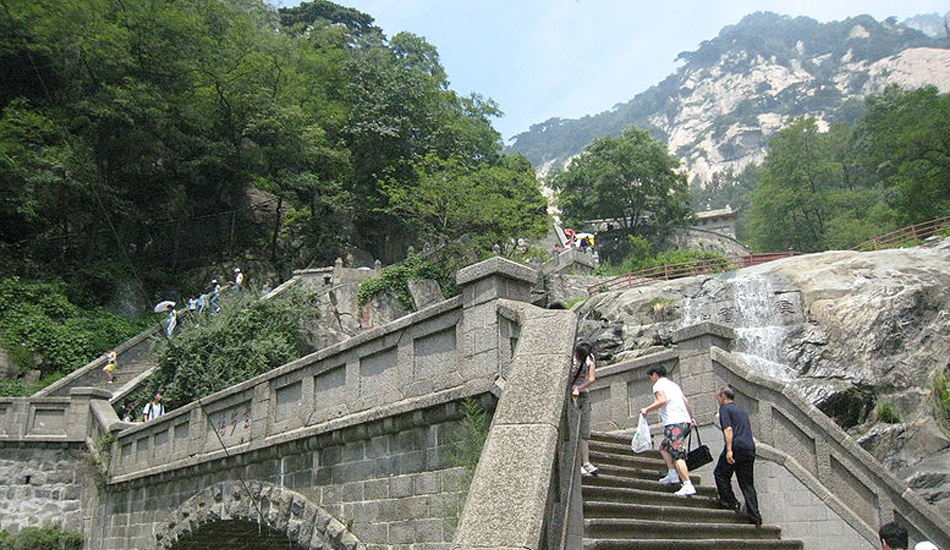“You have no wish to visit any other mountains after viewing the Five Mountains.”*
—Old Chinese saying
Mount Tai, also known as Taishan, is one the most sacred mountains of China. Many Chinese emperors have paid homage to the mountain over several centuries, offering their sacrifices to the earth and the heavens. In fact, one of the first things that a Chinese emperor did after ascending the throne was to conduct a worship of the mountain, since it was seen as necessary to ensure prosperity and stability in the country.
The Path
In China, many mountains are considered to be the abode of immortals. People who wished to cultivate and refine their selves to attain a higher level of consciousness or enlightenment often went up the mountains in search of sages and teachers who would guide them to a true path. These cultivators would often stay on the mountains for a prolonged period of time, cut off from the normal society until they achieved their ultimate goal.
Throughout the passage of time, many cultivators have remained on the mountains, but it is said that they do not casually reveal themselves and only appear to those who sincerely seek the Tao, or the Path. Hence, the Chinese people have always regarded the mountains as sacred.
The geography
Located in Shandong Province, the tallest mountain in Tai is the Jade Emperor Peak, which is well over 5,000 feet and adding 0.5 millimeters every year. Geologists have estimated the mountain to have been formed in the Archeozoic Era, which is thought to have lasted anywhere from 3.8 to 2.5 billion years ago. The mountain faces the Yellow River to its west and the Yellow Sea to its east.
Mount Tai has 156 peaks, 138 cliffs, 72 caves, 64 waterfalls, 130 streams, and 72 grotesque stones in total. Among the peaks, the most famous ones are the Heaven Candle, Jade Emperor, and Sun Viewing Peak. The most popular is the Fan Cliff. Among grotesque stones, the Immortal Bridge gets the most attention. And when it comes to the waterfalls, the Dragon Pool, Santan, and the Yunqiao Waterfall are all popular with visitors.
Mount Tai is spread over 25,000 hectares, with almost 80 percent of the region covered with dense vegetation. There are an estimated 1,000 species of flora in the region. Mount Tai was declared a UNESCO world heritage site in 1987.
The culture
For more than 3,000 years, millions of Chinese have climbed the slopes of Mount Tai as a sacred journey. Even today, enthusiasm among people to walk the 6,000 steps to the top of the mountain has not diminished.

In addition to emperors visiting the place for sacrifices and homage, several of China’s great poets and philosophers have also spent significant time on the mountain. In fact, Confucius is said to have stood atop the mountain, looked down on the land beneath, and stated how the world appeared very small.
There are more than 2,000 historical relics on the mountain. Bixia Temple is the most famous of all temples in the region, mostly due to its scale and the materials used in its construction. It houses a bronze statue of Goddess Yuanjun, with two courtyards. The temple is considered one of the best examples of Taoist construction. Another famous temple atop Mount Tai is Dai Temple. This is the biggest ancient building complex in the region and also the best-preserved.

via wikimedia CC BY-SA 2.5)
Visiting Mount Tai
Since there are no direct flights to the place, you will have to book a plane to the Yaoqiang Airport at Jinan. You can then take a train to the Taishan Railway Station, which is also the transportation hub of the entire region. There are several buses available from the station to the different mountain gates.
Though there are many routes to the summit of Mount Tai, the most popular one is the eastern route. This is believed to be the same route taken by ancient emperors when they came to pay respects. As such, opting this way is your best option to appreciate the cultural aspect of the mountain.
* Tai Mountain (Shandong), Heng Mountain (Hunan), Hua Mountain (Shaanxi), Heng Mountain (Shanxi), and Song Mountain (Henan).
Follow us on Twitter or subscribe to our weekly email







